Abstract
Objectives.
Women who have sex with women are a relatively hidden group that has been overlooked in most AIDS research and prevention efforts, primarily because the efficiency of HIV transmission between female partners is believed to be low. Although data are scant, it is commonly assumed that members of this population are not at high risk for HIV infection. However, a recent study of lesbian and bisexual women living in the San Francisco Bay area reported a relatively high seroprevalence rate and has raised additional questions about this group's HIV risk. The present study, the first to focus on lesbian and bisexual women living outside major AIDS epicenters, provides additional evidence. It describes risk factors for HIV transmission among lesbian and bisexual women living in small cities in four geographic regions of the United States.
Methods.
On three consecutive evenings in 1992, members of the research team distributed anonymous structured written surveys to women patrons as they entered gay bars in each of 16 small cities.
Results.
Almost 17% of bisexual respondents and 0.5% of lesbians reported having had unprotected vaginal or anal sex with a male during the two months prior to the survey. Almost 10 percent of bisexual women and 8.8% of lesbians in the sample reported a history of injection drug use. Among those women surveyed who said they had been tested, 1.4% reported they were infected with HIV.
Conclusions.
Self-identified sexual orientation was highly consistent with recent sexual behavior. HIV risk related to sexual behavior was concentrated among self-identified bisexual women. The prevalence of injection drug use was substantial among both bisexual and lesbians. Developers of HIV risk behavior programs should take the prevalence of these risk behaviors into consideration in the design of effective HIV prevention interventions tailored to the needs of this hidden population.
Full text
PDF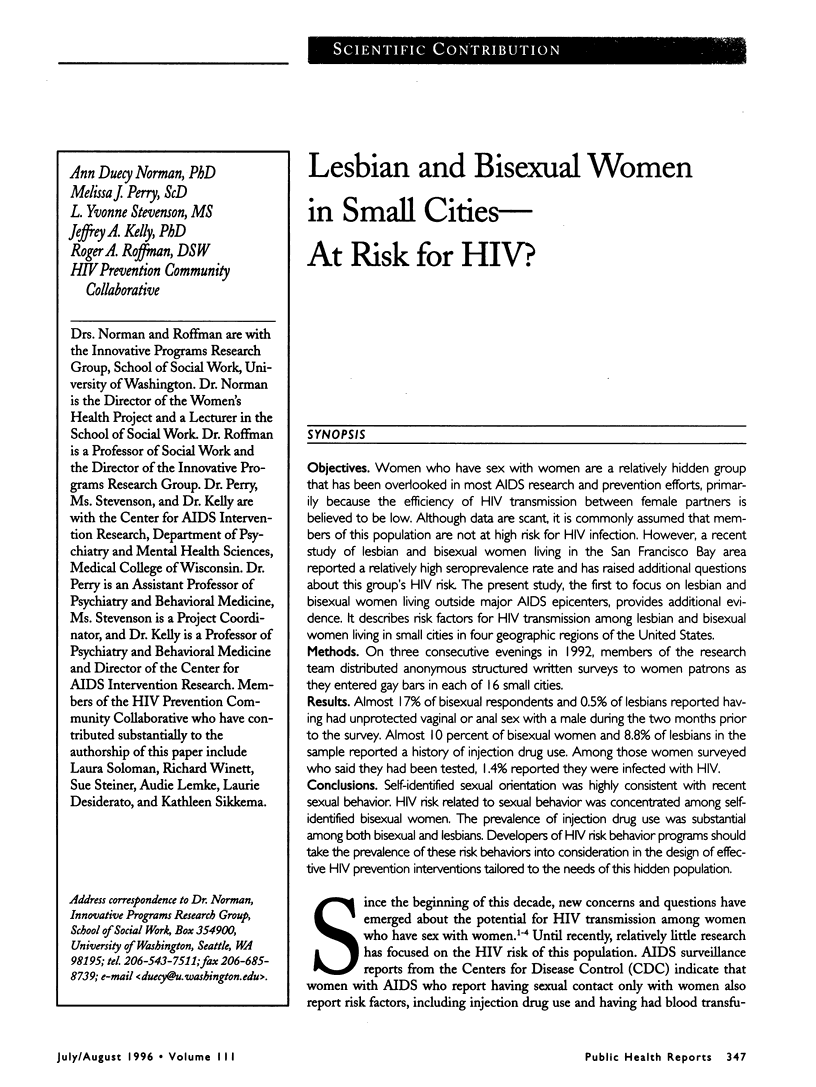
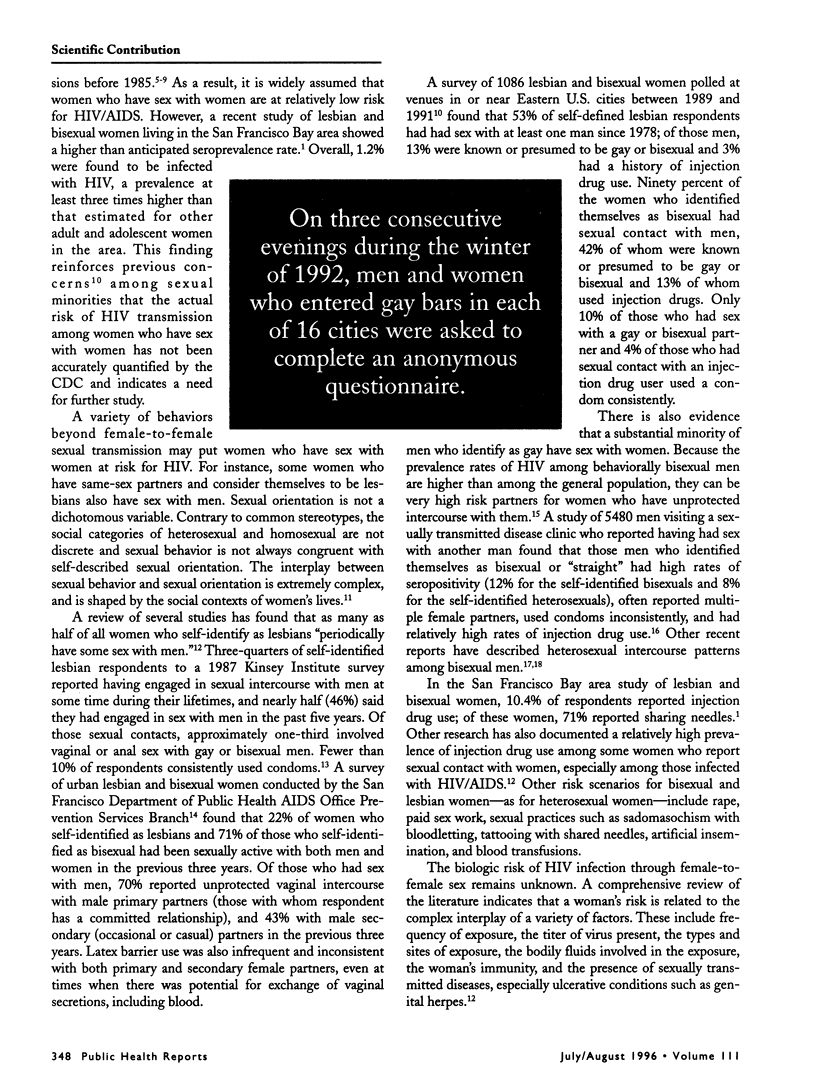
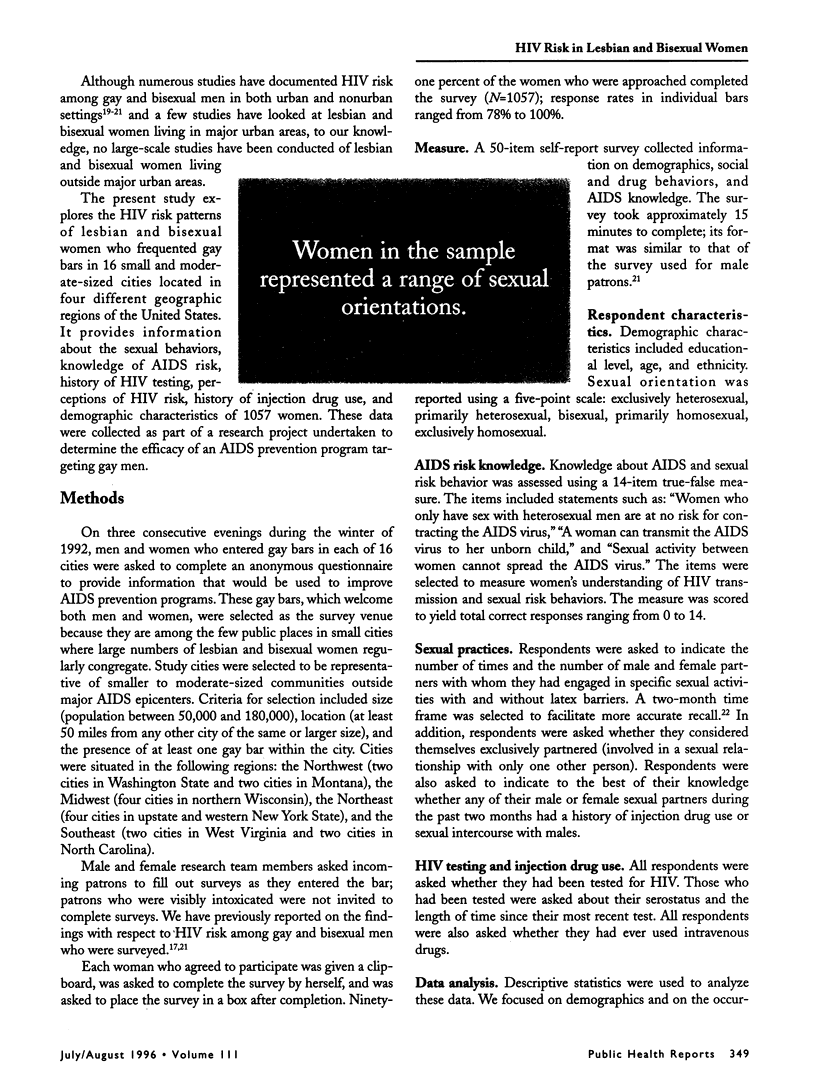
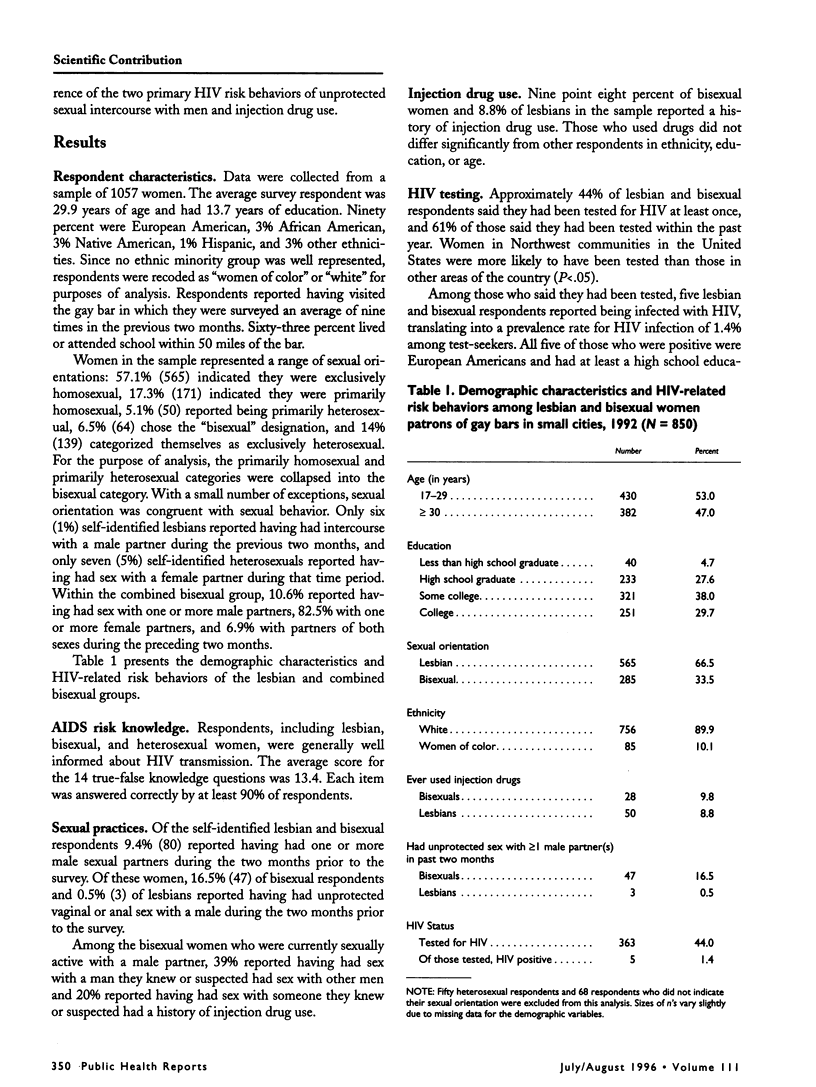
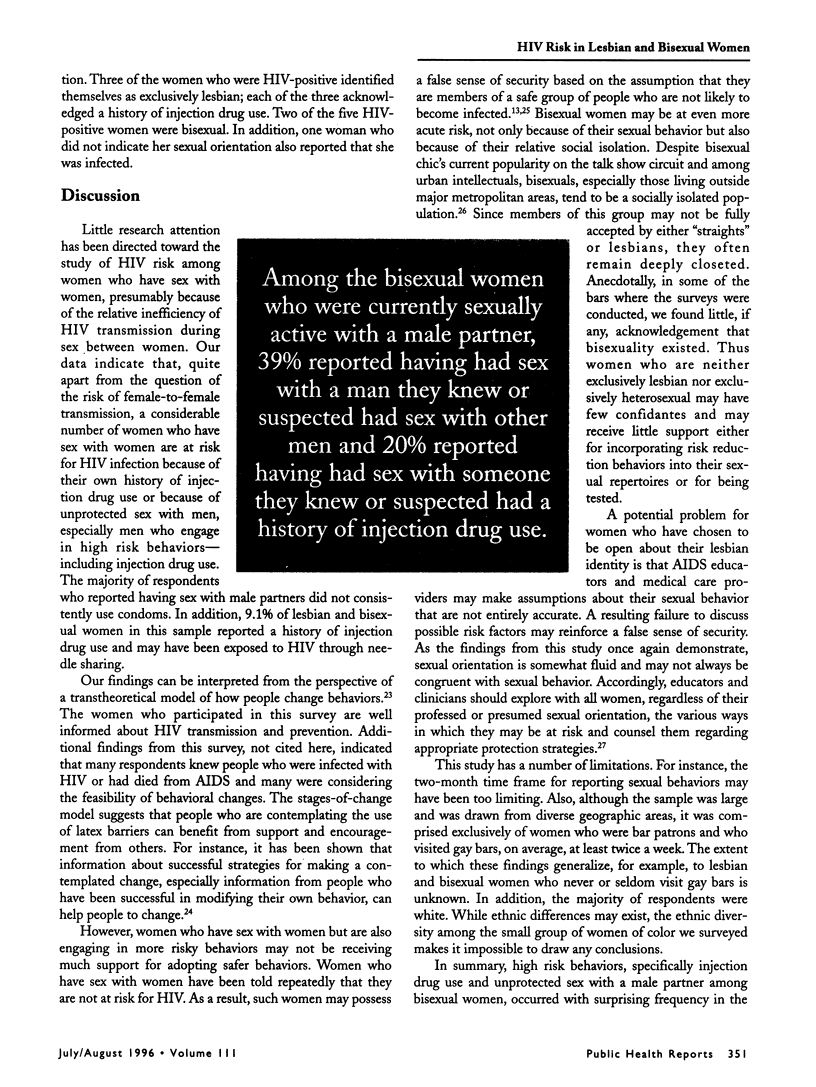
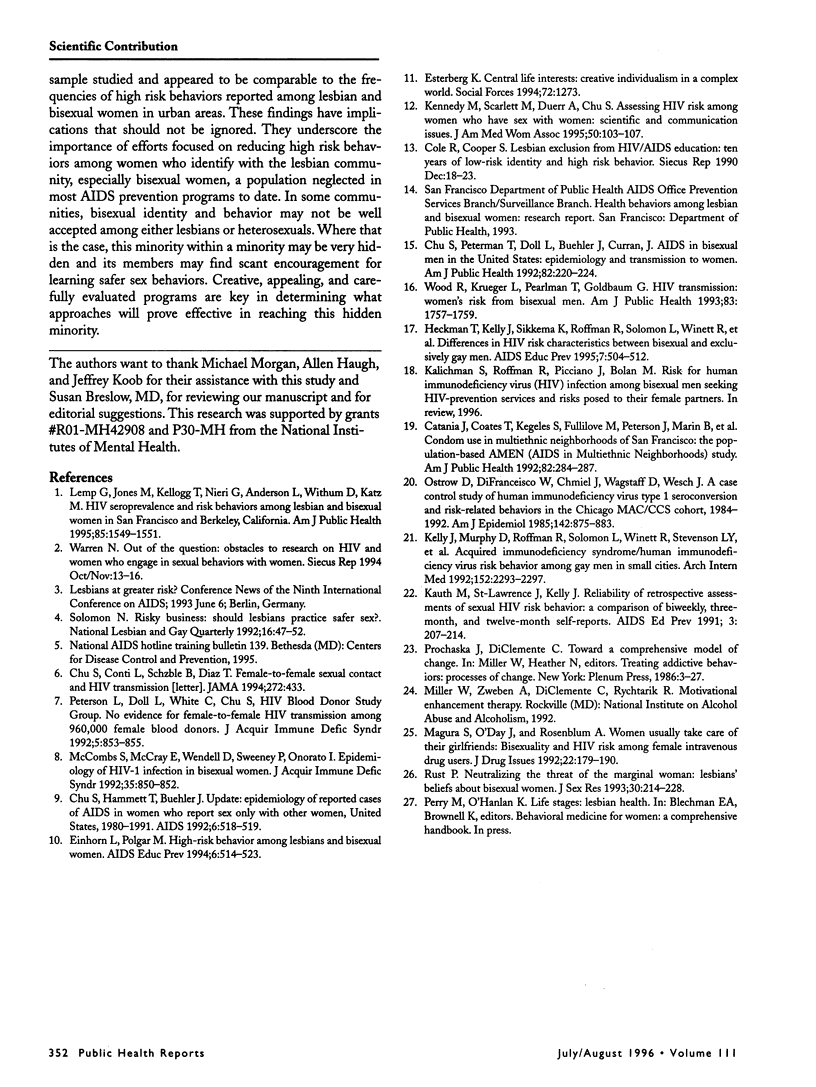
Selected References
These references are in PubMed. This may not be the complete list of references from this article.
- Catania J. A., Coates T. J., Kegeles S., Fullilove M. T., Peterson J., Marin B., Siegel D., Hulley S. Condom use in multi-ethnic neighborhoods of San Francisco: the population-based AMEN (AIDS in Multi-Ethnic Neighborhoods) Study. Am J Public Health. 1992 Feb;82(2):284–287. doi: 10.2105/ajph.82.2.284. [DOI] [PMC free article] [PubMed] [Google Scholar]
- Chu S. Y., Conti L., Schable B. A., Diaz T. Female-to-female sexual contact and HIV transmission. JAMA. 1994 Aug 10;272(6):433–433. [PubMed] [Google Scholar]
- Chu S. Y., Hammett T. A., Buehler J. W. Update: epidemiology of reported cases of AIDS in women who report sex only with other women, United States, 1980-1991. AIDS. 1992 May;6(5):518–519. [PubMed] [Google Scholar]
- Chu S. Y., Peterman T. A., Doll L. S., Buehler J. W., Curran J. W. AIDS in bisexual men in the United States: epidemiology and transmission to women. Am J Public Health. 1992 Feb;82(2):220–224. doi: 10.2105/ajph.82.2.220. [DOI] [PMC free article] [PubMed] [Google Scholar]
- Einhorn L., Polgar M. HIV-risk behavior among lesbians and bisexual women. AIDS Educ Prev. 1994 Dec;6(6):514–523. [PubMed] [Google Scholar]
- Heckman T. G., Kelly J. A., Sikkema K. J., Roffman R. R., Solomon L. J., Winett R. A., Stevenson L. Y., Perry M. J., Norman A. D., Desiderato L. J. Differences in HIV risk characteristics between bisexual and exclusively gay men. AIDS Educ Prev. 1995 Dec;7(6):504–512. [PubMed] [Google Scholar]
- Kauth M. R., St Lawrence J. S., Kelly J. A. Reliability of retrospective assessments of sexual HIV risk behavior: a comparison of biweekly, three-month, and twelve-month self-reports. AIDS Educ Prev. 1991 Fall;3(3):207–214. [PubMed] [Google Scholar]
- Kelly J. A., Murphy D. A., Roffman R. A., Solomon L. J., Winett R. A., Stevenson L. Y., Koob J. J., Ayotte D. R., Flynn B. S., Desiderato L. L. Acquired immunodeficiency syndrome/human immunodeficiency virus risk behavior among gay men in small cities. Findings of a 16-city national sample. Arch Intern Med. 1992 Nov;152(11):2293–2297. [PubMed] [Google Scholar]
- Kennedy M. B., Scarlett M. I., Duerr A. C., Chu S. Y. Assessing HIV risk among women who have sex with women: scientific and communication issues. J Am Med Womens Assoc. 1995 May-Aug;50(3-4):103–107. [PubMed] [Google Scholar]
- Lemp G. F., Jones M., Kellogg T. A., Nieri G. N., Anderson L., Withum D., Katz M. HIV seroprevalence and risk behaviors among lesbians and bisexual women in San Francisco and Berkeley, California. Am J Public Health. 1995 Nov;85(11):1549–1552. doi: 10.2105/ajph.85.11.1549. [DOI] [PMC free article] [PubMed] [Google Scholar]
- McCombs S. B., McCray E., Wendell D. A., Sweeney P. A., Onorato I. M. Epidemiology of HIV-1 infection in bisexual women. J Acquir Immune Defic Syndr. 1992;5(8):850–852. doi: 10.1097/00126334-199208000-00016. [DOI] [PubMed] [Google Scholar]
- Ostrow D. G., DiFranceisco W. J., Chmiel J. S., Wagstaff D. A., Wesch J. A case-control study of human immunodeficiency virus type 1 seroconversion and risk-related behaviors in the Chicago MACS/CCS Cohort, 1984-1992. Multicenter AIDS Cohort Study. Coping and Change Study. Am J Epidemiol. 1995 Oct 15;142(8):875–883. doi: 10.1093/oxfordjournals.aje.a117727. [DOI] [PubMed] [Google Scholar]
- Petersen L. R., Doll L., White C., Chu S. No evidence for female-to-female HIV transmission among 960,000 female blood donors. The HIV Blood Donor Study Group. J Acquir Immune Defic Syndr. 1992;5(9):853–855. [PubMed] [Google Scholar]
- Wood R. W., Krueger L. E., Pearlman T. C., Goldbaum G. HIV transmission: Women's risk from bisexual men. Am J Public Health. 1993 Dec;83(12):1757–1759. doi: 10.2105/ajph.83.12.1757. [DOI] [PMC free article] [PubMed] [Google Scholar]


